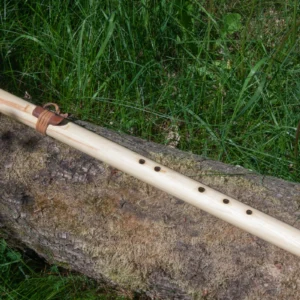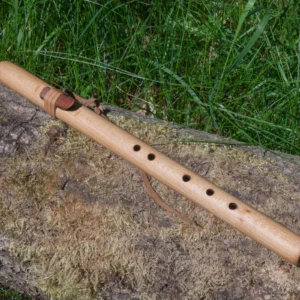In the summer of 2020, I built my first Native flute. I had already built several overtone flutes with varying degrees of success. But I had never played a melodic flute before, except for the nose flute I had as a child.
It was supposed to be just a fun experiment. I love tinkering around in my workshop and trying new things.
But then when I realized how easy it was to make a beautiful sound with my first flute, I thought, 'Great, this is exactly what kids should be given instead of recorders: no more terrible squeaking.'
This is something that everyone can play, or actually: This is something that everyone should play.
As you can see here, I've made a few more.
Later I learned that it's still possible to make some hair-raising sounds, but it's rare, unless you want to... Like children often do.
For my flutes, I use a variety of woods. I primarily use wood from native trees, when not native then recycled wood or leftover pieces.I don't buy exotic woods. I prefer to use wood that I collect myself from the forest near where I live."
For birds or totems, I mostly use tropical hardwood. I like the contrast. It can be anything from bankirai from an old terrace, mahogany from a boat to meranti from a window frame. I never use new tropical hardwood.
Most of the flutes I make are five-hole flutes, tuned in pentatonic minor. Personally, I don't see much point in the six-hole 'pentatonic' variant. They're not really pentatonic anymore, and I find it very impractical that you almost always have to cover that extra hole. That's why many six-hole flutes come with a leather band to cover the hole... so you can play more relaxed!? I prefer not to make a hole that you almost always have to cover anyway. The 'missing' note can still be produced well from the flute if you cover the first and third holes from the top.
A big topic... or not. I make both and like both... but which is better? It depends on what you want. To play together with others, 440 Hz is usually better because it is the standard pitch and the majority of instruments in circulation will then resonate with your flute. Unless you are in certain esoteric circles where there may be more 432 Hz instruments, then 432 Hz is of course better for you. If you use the flute to play alone or meditate, then it doesn't matter at all what pitch your flute is tuned to. Do you think 432 Hz is better? Go for it, nothing against it. Do you want to use 432 Hz to play in harmony with the Earth? Then know:
Playing in harmony with the Earth comes from the heart, and numbers don't matter there.
Birdsong doesn't even have a fixed pitch, but it's definitely in harmony with the Earth.
If you're often on the go with your flute, a bag is very practical. If there's a bag pictured with the flute, then one is included. If not, I can gladly send you one for €20. You'll find it Hier
































































